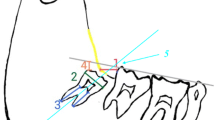Abstract
Purpose
In recent era of computer and software technology, it is necessary to introduce software which helps in routine assessment of surgical procedures practiced in oral surgery. Removal of impacted third molar is a common procedure. It is hard to evaluate factors that complicate removal of impacted third molars because of the large variation among patients and the difficulty in creating a study design. In this article, we have described about our newly designed software developed in order to assess the difficulty in extracting impacted mandibular third molars accurately, thereby reducing the bias faced during the assessment of difficulty in removing impacted mandibular third molar.
Materials and method
A software is designed using C# computer language and Windows Presentation Foundation Framework.
Results
The measurements and angulations are accurately calculated by this software which helps to bring about uniformity in results, thus minimizing the bias during clinical as well as study purposes.
Conclusion
Mandibular third molar difficulty level calculator can be useful software for dental practitioners in day-to-day practice. Dental students and professionals should be made aware of this software so as to utilize it to the utmost possible level.





Similar content being viewed by others
References
Chu FCS, Li TKL, Lui VKB, Newsome PRH, Chow RLK, Cheung LK (2003) Prevalence of impacted teeth and associated pathologies-a radiographic study of the Hong Kong Chinese population. Hong Kong Med J 9:158–163
Coulthard P, Horner K, Sloan P, Theaker E (2003) Master dentistry volume 1. Oral and maxillofacial surgery, radiology, pathology and oral medicine. Churchill Livingstone, New York
Guralnick W (1984) Third molar surgery. Br Dent J 156:389
Quek SL, Tay CK, Tay KH, Toh SL, Lim KC (2003) Pattern of third molar impaction in a Singapore Chinese population: a retrospective radiographic survey. Int J Oral Maxillofacial Surg 32:548–552
Pederson GW (1994) Oral surgery. Philadelphia: WB Saunders, 1988. (Quoted by Koerner KR. The removal of impacted third molars-principles and procedures. Dent Clin North Am 38:261
Peterson LJ (2003) Contemporary oral and maxillofacial surgery. Mosby, Maryland Heights
Dimitroulis G (2001) Handbook of third molar surgery. Australia, Oxford Auckland Boston Johannesburg Melbern New Delhi
Funding
No funding was received for this study.
Author information
Authors and Affiliations
Corresponding author
Ethics declarations
Conflict of interest
All the authors declare that there is no conflict of interest.
Ethical Approval
This article does not contain any studies with human participants or animals performed by any of the authors.
Informed Consent
Informed consent was obtained from all individual participants included in the study.
Additional information
Publisher's Note
Springer Nature remains neutral with regard to jurisdictional claims in published maps and institutional affiliations.
Rights and permissions
About this article
Cite this article
Ansari, M.A.M.F., Mutha, A. Digital Assessment of Difficulty in Impacted Mandibular Third Molar Extraction. J. Maxillofac. Oral Surg. 19, 401–406 (2020). https://doi.org/10.1007/s12663-019-01265-2
Received:
Accepted:
Published:
Issue Date:
DOI: https://doi.org/10.1007/s12663-019-01265-2




